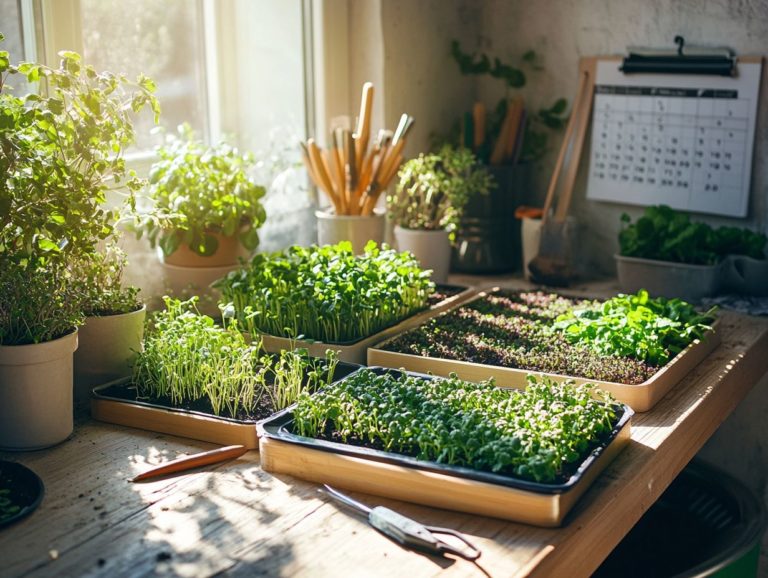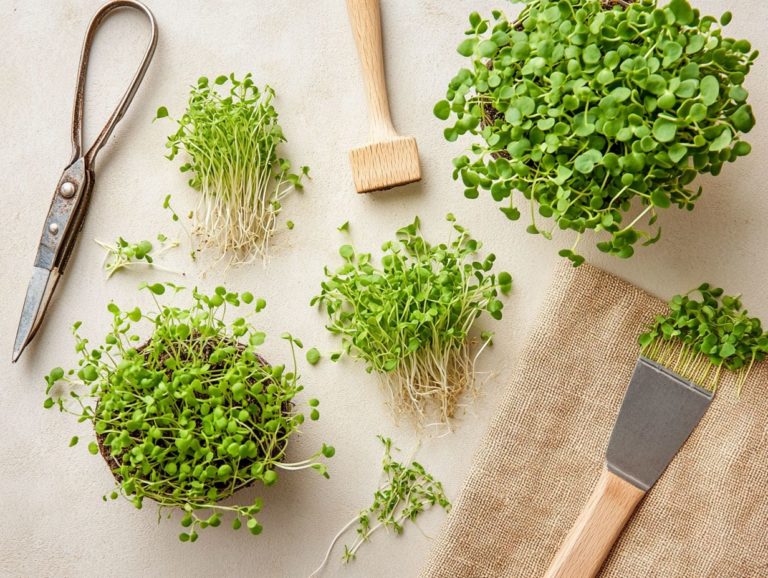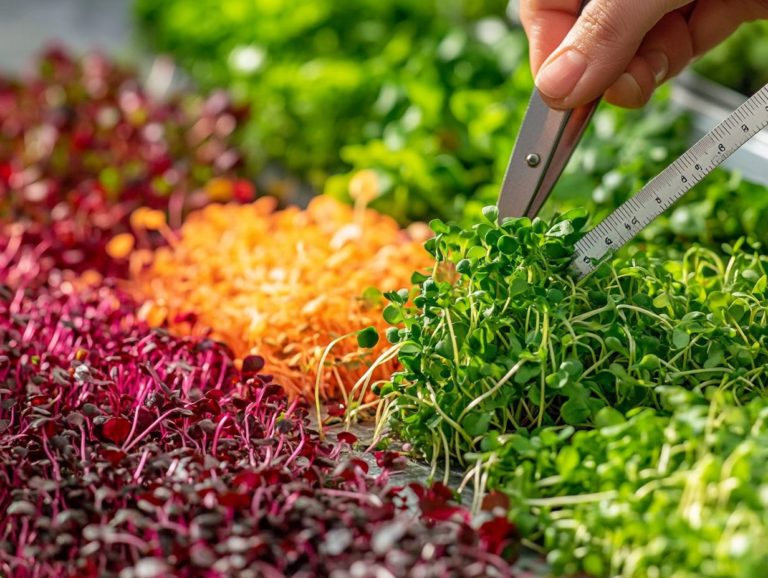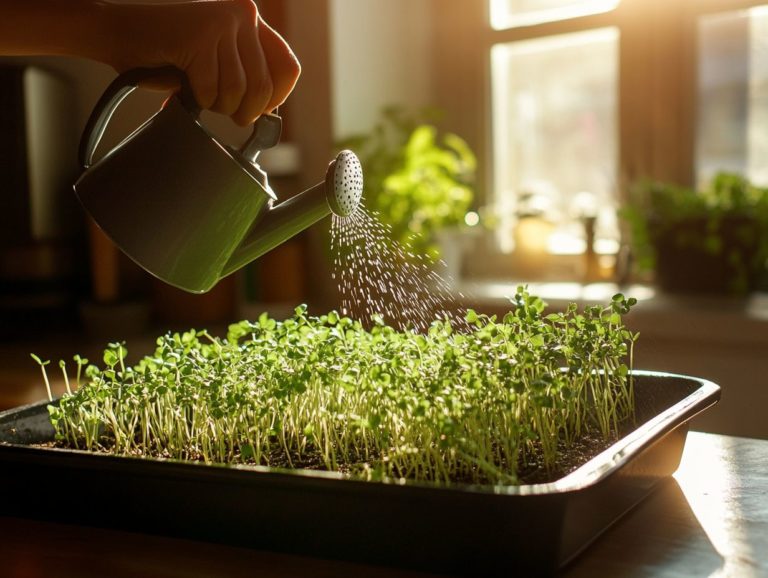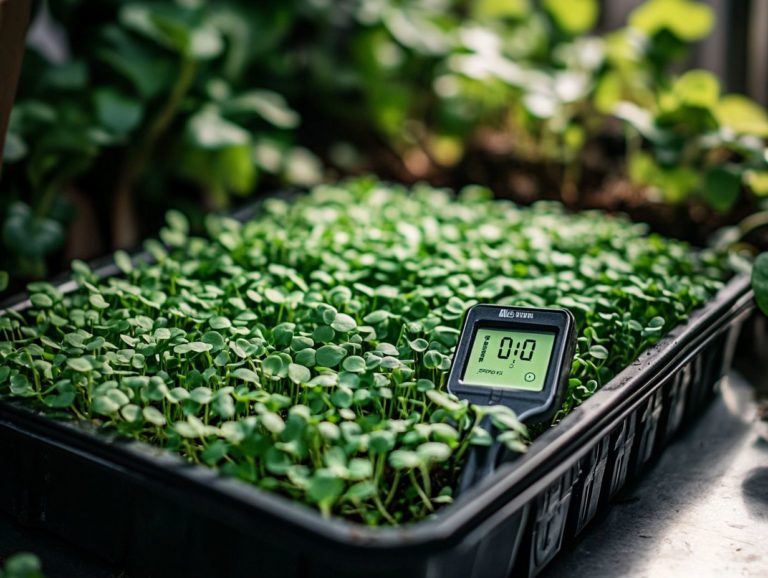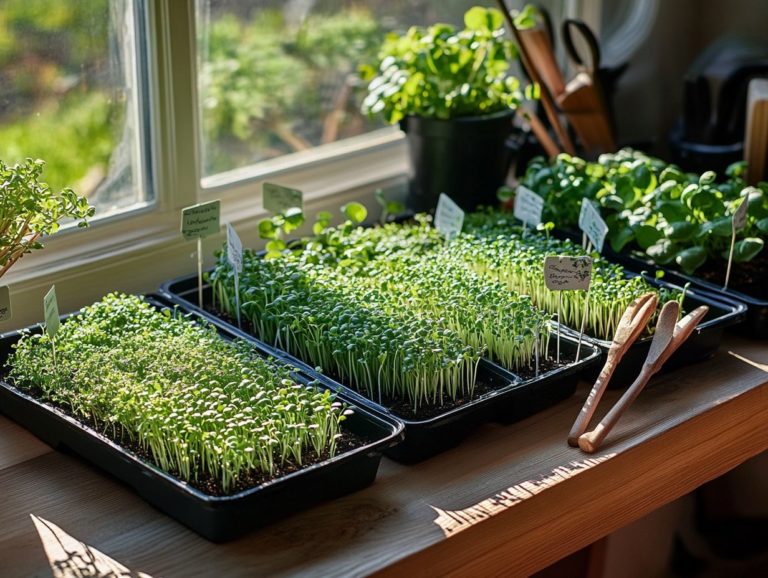The Role of Temperature in Microgreen Growth
Microgreens have surged in popularity within the culinary realm, renowned for their vibrant flavors and remarkable nutritional profiles.
Cultivating these petite greens requires more than merely sowing seeds. Temperature is a pivotal factor in their growth. Understanding how temperature affects germination the process where seeds sprout and begin to grow growth rates, and overall health will make a significant difference between flourishing microgreens and a lackluster harvest.
This article delves into the ideal temperature ranges, the variables influencing temperature control, and the common challenges growers encounter. This will arm you with essential knowledge for successful microgreen gardening.
Contents
- Key Takeaways:
- The Importance of Temperature in Microgreen Growth
- Factors Affecting Temperature in Microgreen Growth
- Controlling Temperature for Optimal Growth
- Common Challenges in Microgreen Growth
- Frequently Asked Questions
- What is the role of temperature in microgreen growth?
- What is the ideal temperature for microgreen growth, especially for students focusing on community supported agriculture (CSA)?
- How does temperature affect the germination of microgreens?
- Can microgreens tolerate extreme temperatures?
- What happens if the temperature is too high for microgreen growth?
- What happens if the temperature is too low for microgreen growth?
Key Takeaways:
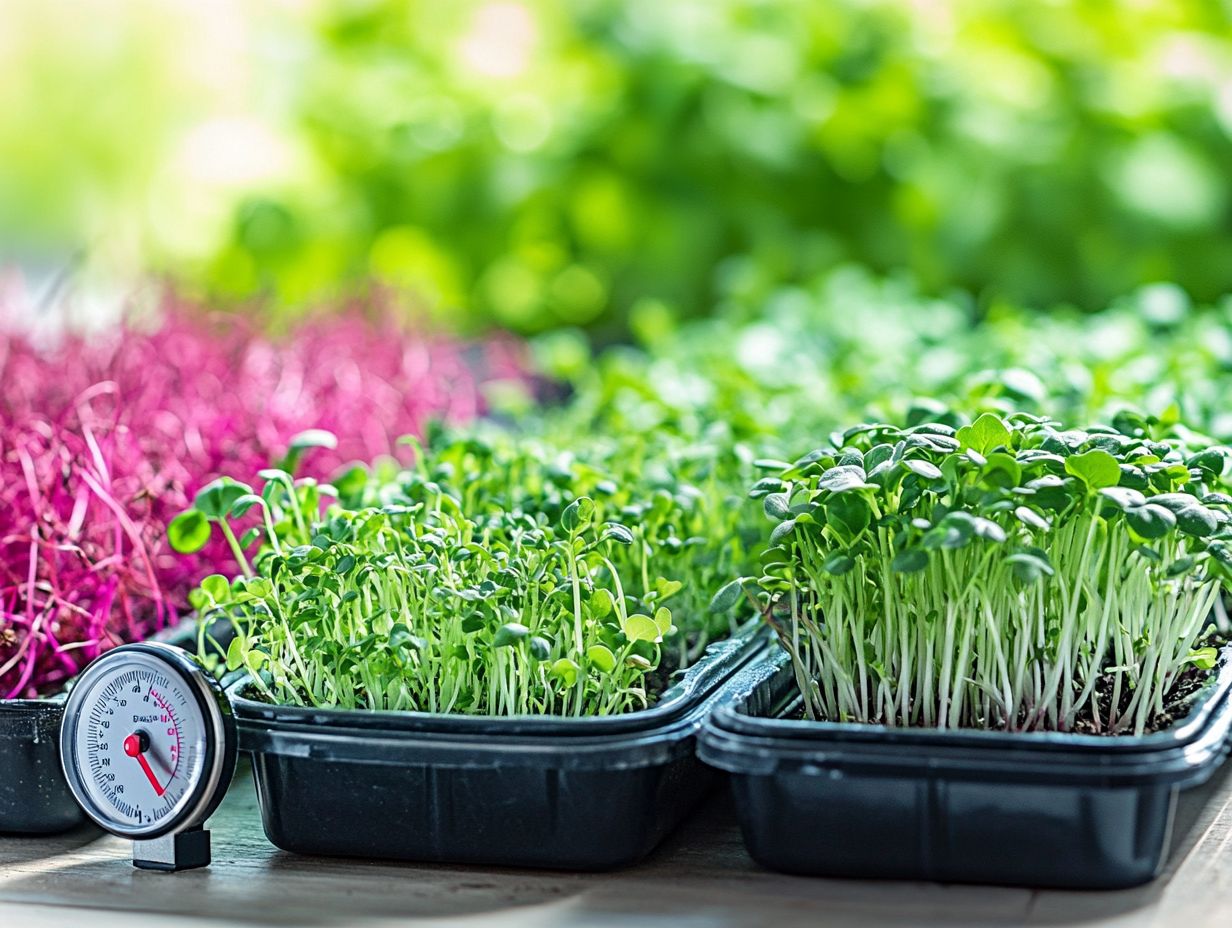
- Control temperature to boost microgreen growth and enhance germination.
- Manage light exposure and humidity levels for optimal growth.
- Maintain a consistent and controlled temperature to overcome challenges and ensure successful microgreen production.
What are Microgreens?
Microgreens are young, edible plants harvested at an early stage, usually between 7 to 21 days after germination. Packed with flavors, vitamins, and nutrients, they ve become the go-to choice for health-conscious consumers and chefs alike.
Enjoy vibrant flavors and essential nutrients with varieties like cilantro, kale, and basil. These greens not only bring unique colors and textures to your plate but also elevate dishes such as salads, sandwiches, and tacos. With the rising demand for local produce, microgreens are stepping into the spotlight in community-supported agriculture (CSA) initiatives and farmers markets, benefiting both consumers and restaurants eager for fresh options.
These tiny greens are often loaded with antioxidants and essential vitamins, prompting nutritionists to tout them as an effortless way to enhance your health. Chefs frequently turn to microgreens for their striking presentation and intense flavors, transforming everyday meals into gourmet experiences.
The plants thrive in controlled environments, requiring minimal space and resources, making them perfect for urban farming efforts. This adaptability promotes sustainable practices and strengthens local food systems, allowing restaurants to showcase seasonal, nearby ingredients on their menus while cultivating a deeper connection with the community.
The Importance of Temperature in Microgreen Growth
Temperature is a critical factor in the growth of microgreens. It affects everything from germination to harvesting. The right temperature influences seedling development and determines the overall health and quality of your crops.
Maintaining optimal temperature conditions is essential for microgreens like arugula, radish, and mustard to flourish. Understanding microgreen growth rates ensures successful production and profitability for those committed to organic farming.
Effects of Temperature on Germination
Temperature plays a pivotal role in the germination process of microgreens. It influences how quickly seeds absorb water and begin to sprout. A consistent temperature range is vital for achieving uniform germination. Extreme temperatures can hinder this process or result in subpar seedling development.
For example, varieties like kale and radish flourish best in a temperature range of 65 F to 75 F. Conversely, herbs such as basil thrive in slightly warmer conditions, ideally between 70 F and 80 F, to germinate effectively. Peas, a favorite among growers, show optimal germination at temperatures ranging from 60 F to 70 F. Data indicates that for every degree Fahrenheit outside these ideal ranges, germination rates might plummet sometimes dropping by as much as 50%.
Therefore, creating an environment that closely mimics these conditions is essential for cultivating robust and healthy microgreen crops.
Ready to start your microgreen garden? Subscribe for more tips and tricks!
Optimal Temperature Range for Growth
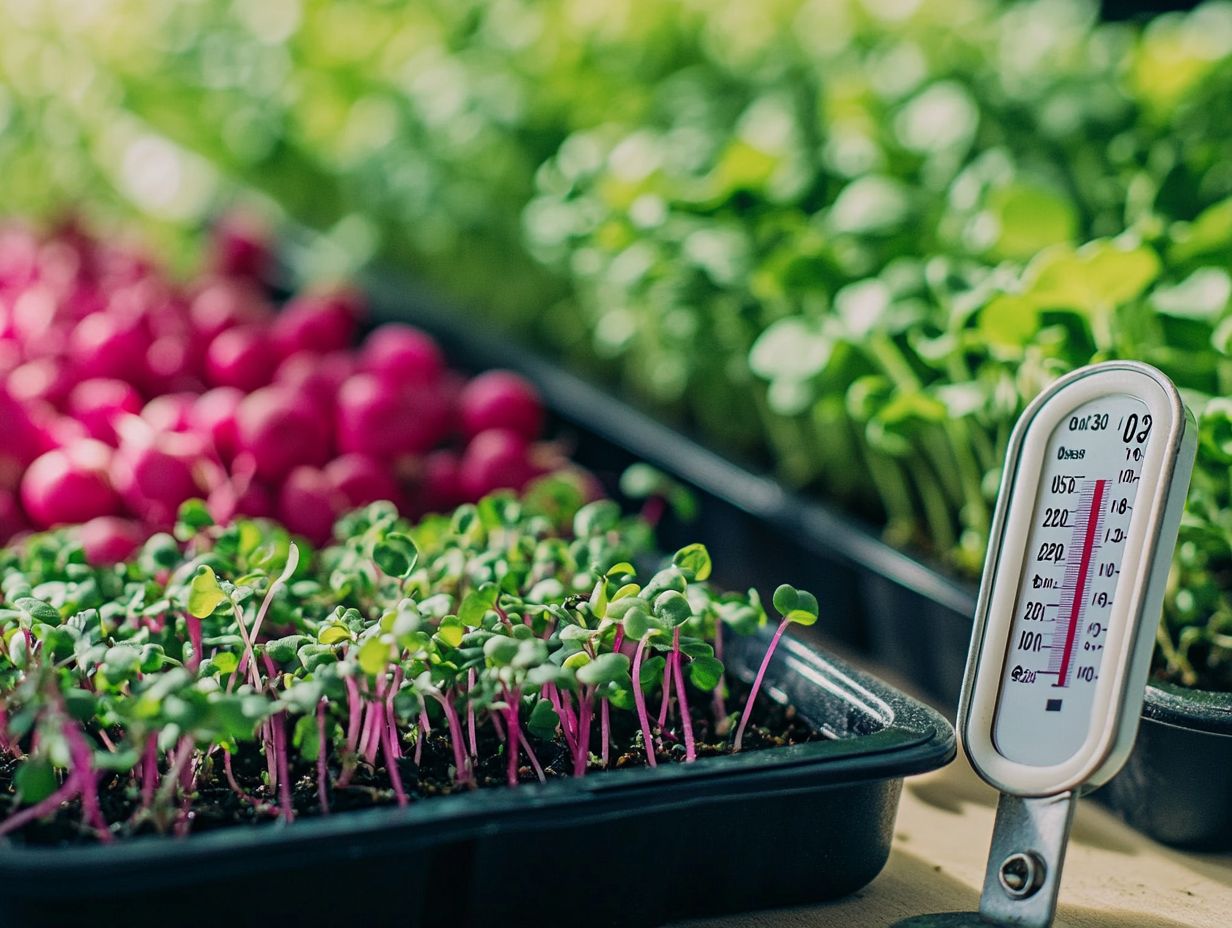
The optimal temperature for growing microgreens is between 65 F to 75 F (18 C to 24 C). Within this range, you’ll see robust growth and impressive yields.
By maintaining these conditions, you ensure that your microgreens develop their distinctive flavors and vibrant colors. This practice also maximizes their nutritional benefits.
It’s essential to harmonize factors like light exposure and humidity with temperature to create the perfect growing environment.
Take varieties like arugula and radish; they thrive beautifully within this range. This leads to quicker harvest times and delightful taste.
Letting temperatures drop below 60 F (15 C) can significantly slow growth. Excessive heat above 80 F (27 C) may cause plants to become leggy. This compromises their sturdiness and flavor.
Using the right light spectrum, ideally a blend of blue and red wavelengths, along with humidity levels around 50% to 70%, is crucial. Achieving this balance of temperature, light, and moisture helps cultivate nutrient-rich microgreens that impress both chefs and health enthusiasts, as explained in the science behind microgreen growth.
Factors Affecting Temperature in Microgreen Growth
Several factors play a crucial role in determining temperature during microgreen growth. These include light exposure, humidity levels, and the cultivation systems you use.
It s vital to manage these elements effectively to establish an environment that nurtures healthy plants from germination to harvesting.
By understanding how these factors interact, you can refine your methods. This optimization ensures a bountiful yield.
Light Exposure
Light exposure plays a pivotal role in the growth of microgreens. It directly influences photosynthesis the process plants use to turn light into energy and overall plant health.
The type and duration of light, whether natural or artificial, significantly impact the growth rate and quality of your microgreens. To really optimize your results, understanding microgreen growth cycles enhances the vigor and nutritional value of your crops, resulting in improved flavors and textures.
Different light sources like fluorescent, LED, and sunlight offer unique benefits and wavelengths. For instance, fluorescent lights might be enough for species that require less light, while LED lights provide a broader spectrum and greater efficiency, encouraging quicker growth.
Aim for an ideal light duration of 12 to 16 hours each day, mimicking the natural daylight cycle. This approach promotes robust growth and nurtures plant health.
Understanding how light impacts photosynthesis allows you to create an environment where your microgreens can truly thrive, maximizing both their potential and nutritional yield.
Humidity Levels
Humidity levels are essential for cultivating microgreens. They influence both water retention in the soil and the plants’ transpiration rates.
Ideally, maintain humidity between 40% and 60% to encourage optimal growth while keeping mold and disease at bay. Understanding these dynamics allows you to implement effective systems that protect your crops health and enhance their marketability.
Excessive humidity can lead to too much moisture in the soil, risking root rot or fungal diseases. Finding a balance is crucial. For example, crops like basil and arugula flourish within this humidity range, encouraging healthy leaf expansion and vibrant colors.
Transpiration is key for nutrient uptake; when humidity is too high, low transpiration can stunt growth. Keeping humidity within the ideal range helps avoid these issues, boosting the overall yield and quality of your microgreens.
You can also use tools like humidity monitors to adapt conditions on the fly, ensuring optimal conditions at every stage of growth.
Start your microgreens journey today!
Controlling Temperature for Optimal Growth
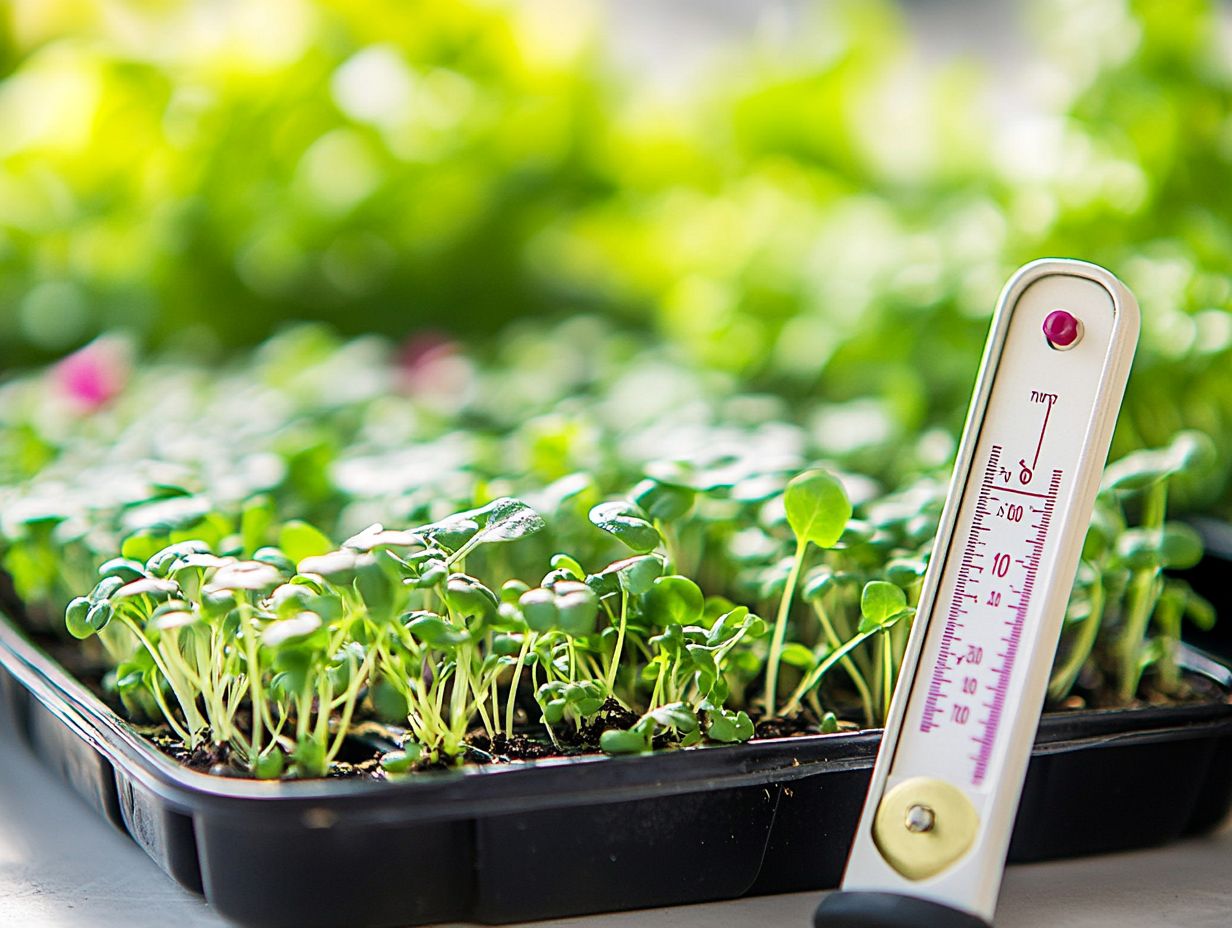
Controlling temperature is crucial for achieving optimal growth in your microgreens. There are several easy methods at your disposal to maintain the ideal conditions.
You can utilize heating mats, thermostats, and advanced environmental control systems to effectively regulate temperature throughout the growing process.
By implementing these strategies, you ll ensure consistent growth and cultivate high-quality crops that are perfectly primed for harvesting.
Methods for Maintaining Temperature
Several methods are available for maintaining temperature in microgreen cultivation, each tailored to suit your specific growing environment and system. Techniques such as utilizing greenhouses and temperature-controlled rooms effectively regulate temperature, creating ideal growth conditions.
Hydroponic systems, which involve growing plants in water without soil, also allow for temperature regulation, supporting efficient nutrient uptake. By employing these methods, you can maximize your yields and ensure the health of your microgreens. If you encounter any challenges, check out troubleshooting common microgreen growth issues for guidance.
For instance, using greenhouses provides a natural buffer against external temperature fluctuations, enhancing your microgreens’ resilience. However, keep in mind that this method can be costly to set up and maintain. On the other hand, temperature-controlled rooms can deliver consistent temperatures, although they may lead to high energy costs over time. To better understand how to optimize your growing conditions, explore the understanding of microgreen growth phases.
Each approach comes with its own unique benefits and challenges, so it’s important for you to choose the method that best aligns with your operational needs and resources.
Common Challenges in Microgreen Growth
As a grower of microgreens, you may encounter several challenges that can hinder your success, with temperature-related issues being among the most critical. Fluctuating temperatures, improper humidity levels, and insufficient light exposure can negatively impact seedling development and compromise the quality of your crops.
It’s crucial to tackle these challenges head-on for a thriving crop! Recognizing and addressing these challenges is essential for optimizing your yields and maintaining a competitive edge in the market.
Temperature-Related Obstacles
Temperature-related challenges can significantly impact the growth and quality of your microgreens, leading to issues like stunted growth, poor germination rates, and a greater vulnerability to diseases. When temperatures fluctuate during critical growth stages, they disrupt the delicate balance required for healthy development.
For example, excessively high temperatures might lead to wilting or leaf scorch, while cooler conditions can slow how plants use energy for growth. These temperature variations can also create a welcoming environment for harmful pathogens, which thrive under unstable conditions.
To tackle these issues effectively, consider investing in climate control technologies such as thermostats and grow lights that help maintain optimal conditions. You can also use shade cloths or reflective materials to help regulate heat absorption.
By actively monitoring temperature fluctuations and making necessary adjustments, you can not only boost growth but also enhance the overall resilience of your microgreen crops.
Frequently Asked Questions
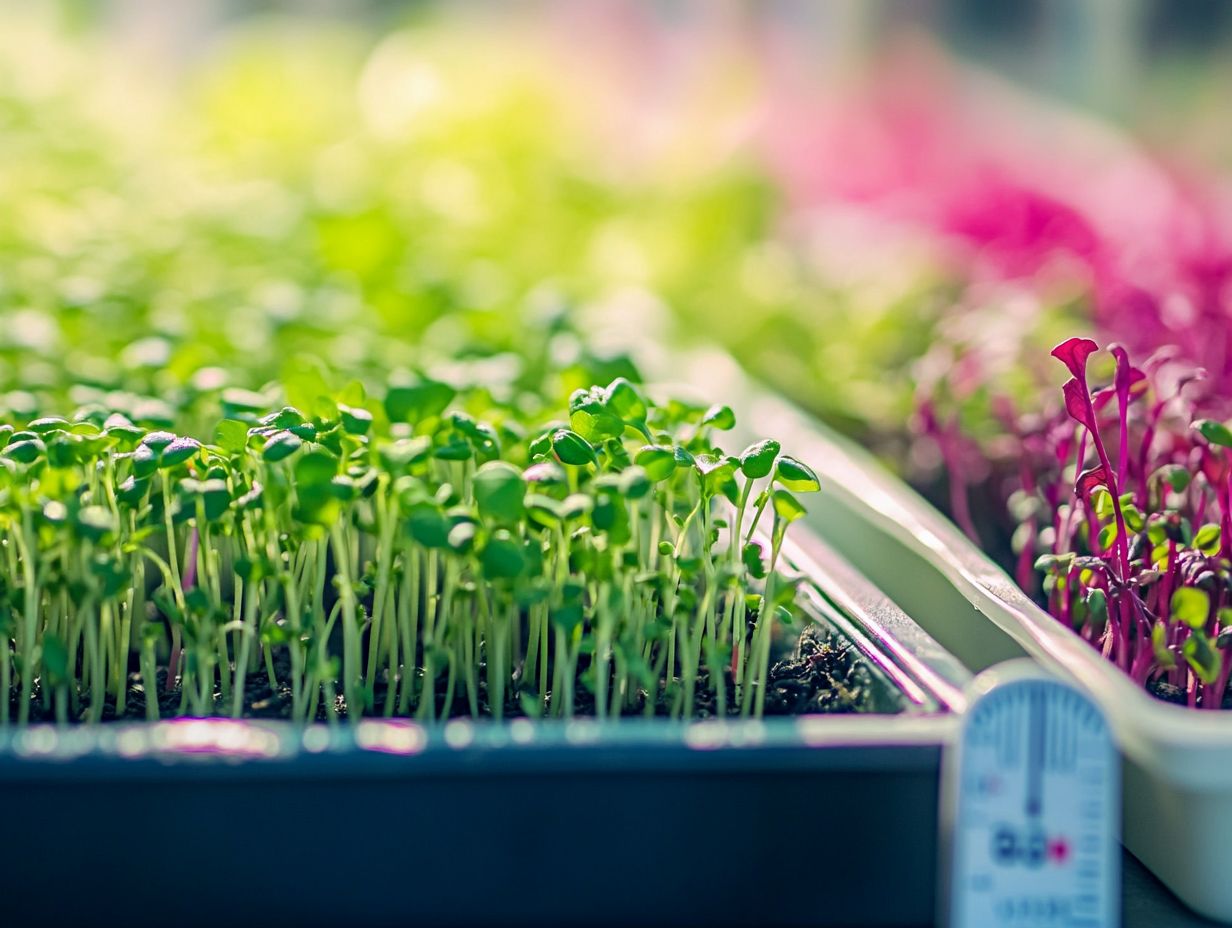
What is the role of temperature in microgreen growth?
The role of temperature in microgreen growth is essential, as it directly affects the plant’s metabolic processes, photosynthesis, and overall growth rate.
What is the ideal temperature for microgreen growth, especially for students focusing on community supported agriculture (CSA)?
The ideal temperature for microgreen growth varies depending on the type of microgreen, but generally, a temperature range of 18-24 degrees Celsius (64-75 degrees Fahrenheit) is recommended.
How does temperature affect the germination of microgreens?
Temperature plays a crucial role in the germination of microgreens. Higher temperatures speed up germination. However, excessive heat can dry out seeds and kill them.
Can microgreens tolerate extreme temperatures?
No, microgreens are sensitive plants. They struggle in temperatures above 30 C (86 F) or below 10 C (50 F). These extremes can harm their growth.
What happens if the temperature is too high for microgreen growth?
If the temperature is too high, microgreens can wilt and become discolored. High temperatures make plants lose water quickly, leading to wilting and death.
What happens if the temperature is too low for microgreen growth?
If the temperature is too low, it can slow down growth. Low temperatures can stunt growth, resulting in smaller, less flavorful microgreens.

